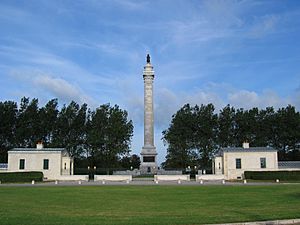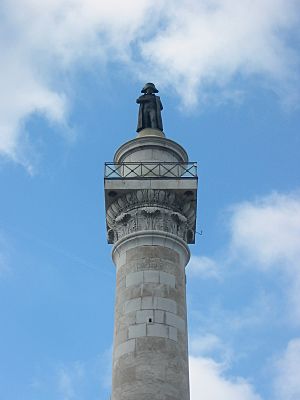Column of the Grande Armée facts for kids
The Column of the Grande Armée (in French, Colonne de la grande Armée or Colonne Napoléone) is a tall monument, about 53 meters (174 feet) high. It's a type of column called a Corinthian triumphal column. This means it was built to celebrate a victory, much like famous columns in Rome such as Trajan's Column. You can find it on Rue Napoleon in Wimille, a town near Boulogne-sur-Mer, France.
Contents
History of the Column
Building the Monument (Before 1815)
This column was first planned to celebrate a successful invasion of England by Napoleon. However, that invasion never happened. Instead, the column now remembers an important event: the first time Napoleon gave out the Légion d'honneur award. This special award was given to soldiers of the Army of England at their camp in Boulogne.
In September 1804, a military leader named Marshal Soult told Napoleon that the army wanted to build a column. The town of Boulogne bought land for it from a woman who wasn't happy about giving up her field for a monument to Napoleon.
A group was formed to build the column. They hired Étienne Éloi Labarre as the architect and Houdon for the bronze work. Jean Guillaume Moitte was chosen for the detailed carvings called bas-reliefs. Soldiers, sailors, and officers all helped pay for the project. They gave part of their pay each month.
The first stone was laid by Marshal Soult on October 9, 1804. This was a big celebration with many awards given out. The stone came from local marble quarries.
After Napoleon's army, known as the Grande Armée, left Boulogne in August 1804, work on the column slowed down. By December 1811, the column was only 20 meters tall, much shorter than the planned 50 meters. The project ran out of money and had to stop. Work completely stopped in 1814 when Napoleon lost power. The statues and carvings meant for the column were melted down.
Restarting Work (1819-1853)
Building work started again in 1819 when the government provided money. The top platform was finished in 1821. A royal globe with fleurs de lys (a symbol of French royalty) and a crown was placed on top in 1823.
After a change in government in 1831, the column was given money for upkeep. The royal crown was removed, and stars replaced the fleurs de lys. In 1831, the column was officially named the Column of the Grande Armée. That same year, Queen Hortense and her son, Louis-Napoléon (who later became Emperor Napoleon III), climbed the column.
In 1838, it was decided to finish the column. François Joseph Bosio was asked to create a new statue of Napoleon. New bas-reliefs were made by Lemaire and Théophile Bra. In June 1838, Marshal Soult visited the column. He hadn't seen it since 1805.
In 1840, Louis-Napoleon tried to take power in a failed attempt. He landed with his supporters at Boulogne and briefly took refuge near the column, raising the imperial flag on it. He was later arrested.
Meanwhile, Bosio's large statue of Napoleon was finished. It weighed 7,500 kilograms (about 16,500 pounds). This statue was ready for when Napoleon's remains were brought back to Paris on December 15, 1840. The statue then traveled to Wimille, arriving on July 26, 1841. It was placed on top of the column on August 15 by the future Napoleon III. Many people, about 50,000, came to see it. The bas-reliefs were added later, in 1843.
On September 27, 1853, Napoleon III and his empress visited Boulogne. He ordered a road to be built leading to the column. He also gathered 10,000 troops on the coast and held a large military review near the column in September 1854.
Recent History (1901-Present)
The column was officially recognized as a historic monument on March 31, 1905. It survived World War I without damage.
However, the column and its 1841 statue were badly damaged by bombing in 1944 during World War II. The park around the column became a German naval cemetery. The original statue was replaced by a new one of Napoleon in a chasseur (hunter) uniform, made by Pierre Stenne. The new statue and the finished restoration work were officially opened on June 24, 1962. Charles de Gaulle, a famous French leader, was there.
The top of the column was hit by lightning on November 19, 1999. This caused serious cracks and some marble blocks fell, but the statue was safe. It was hit by lightning again in 2002. The column has now been fully repaired, and visitors can climb to the top once more.
Description of the Column
There are two small buildings, called pavilions, on either side of the column's base. The one on the right has a free museum. Inside, you can see the original 1841 statue of Napoleon, which has been restored.
One of the bas-reliefs (carved scenes) on the base, made by Bra, shows Marshal Soult presenting the plans for the column to Napoleon. General Bertrand is next to Soult, and Admiral Bruix is behind him.
The other bas-relief, made by Lemaire, shows the first time the Légion d'honneur was awarded on August 16, 1804. This carving also shows Soult, Lacépède, Louis Belmas (the Archbishop of Cambrai), and Hugues-Robert-J.-Ch. De La Tour d'Auvergne Lauragais (the Bishop of Arras) standing near Napoleon.
Inside the base of the column, there is a room with copies of busts (sculptures of heads and shoulders) of Napoleon. Two bronze lions, made by Jean-Guillaume Moitte, guard the entrance to the base. The base is surrounded by railings decorated with the golden French Imperial eagle, a symbol of Napoleon's empire.



